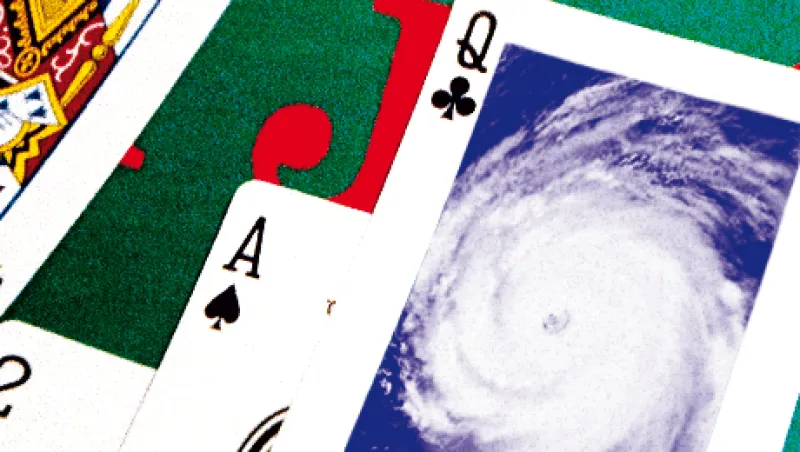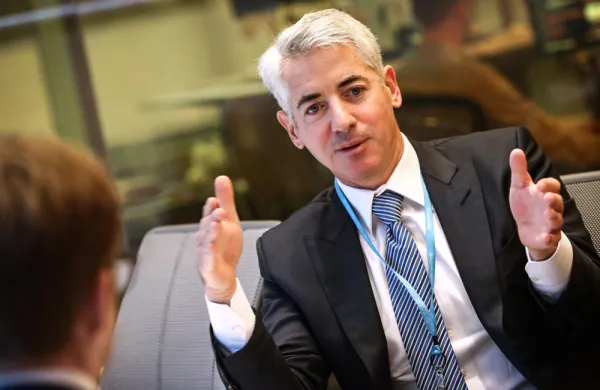The low-yield investment climate has left registered investment advisers searching for new opportunities to make it rain for their clients. Some believe they’ve found a way — as long as that rain doesn’t come with flooding and gale-force winds. Catastrophe bonds, insurance-linked securities tied to natural disasters, have long been a source of yield for hedge fund firms. Now they’ve made it onto the radar of U.S. wealth managers looking to deliver returns with relatively little risk.
“When clients’ life savings are at stake, cat bonds offer opportunities on several levels,” says Sam Sudame, director of research at SingerXenos Wealth Management, an RIA based in Coral Gables, Florida, that has allocated 5 percent of its $1.2 billion portfolio to the asset class. “By its very nature, a quality cat bond portfolio is diversified and offers powerful return compared to the risk — both crucial for private wealth management.”
Family offices in Europe and in East Asia, especially Japan, have been investing in catastrophe bonds for more than a decade, says John Seo, co-founder of $5 billion Fermat Capital Management, a Westport, Connecticut–based specialist in the paper. Pioneered 20 years ago by Warren Buffett and Allstate Insurance Co. in the wake of Hurricane Andrew, which devastated Florida, catastrophe bonds were the domain of alternative managers at first.
More traditional institutional investors such as pension funds followed suit, particularly after the 2008–’09 financial crisis, lured by the promise of returns uncorrelated to a weak market. As they seek to shore up lackluster 60-40 portfolios, RIAs are the latest to embrace what Seo jokingly describes as an “unrisky for a risky” asset class.
A catastrophe bond passes on the risk of what insurers call peak perils from reinsurance companies to investors. Actuaries calculate the likelihood of, say, an 8.5 magnitude earthquake hitting Southern California or a Category 5 hurricane battering the Gulf Coast and price the security accordingly.
If the event covered doesn’t occur before the bond matures — the term of the bond is typically three years — the investor can receive a sizable coupon payout, often LIBOR plus a spread of 3 to 20 percentage points. (Given catastrophe bonds’ popularity, yields have dipped in the past couple of years.) If a natural disaster of the magnitude outlined in the prospectus does strike, though, the bond triggers and the premium goes to the sponsoring reinsurer to help cover policyholder claims.
Here’s why catastrophe bonds are risky yet unrisky: Looking beyond their ratings, which are typically in the double-B range, the triggering calamity tends to be unlikely. “With events such as Hurricane Irene and the tsunami in Japan, 2011 was one of the worst years for the reinsurance industry,” notes Canon Hickman, a wealth manager at Henrico, Virginia–based Equity Concepts, whose $700 million in assets include catastrophe bonds. “Yet only four out of some 120 cat bonds were impacted.” In fact, the market edged up that year because those disasters reminded investors of catastrophe bonds’ existence.
Since Zurich-based Swiss Reinsurance Co. began tracking catastrophe bonds in 2002, there hasn’t been a down year: Through 2015 the Swiss Re Cat Bond Index gained an annual average of almost 7.7 percent. Compare that to the jitters sparked by recent geopolitical events such as Brexit, and it’s easy to see why RIAs like an asset class uncorrelated to the equity and fixed-income markets.
Still, investors shouldn’t ignore the real risk that a bond will get triggered, Hickman warns. An effective catastrophe bond portfolio is diversified geographically and by type of event, he maintains.
As newcomers to the asset class, wealth managers must also pay close attention to due diligence. Before Joseph Zappia, managing partner and principal at LVW Advisors, a $3 billion RIA based in Pittsford, New York, decided to allocate to catastrophe-linked securities, which are related to but different from catastrophe bonds, he spent 18 months investigating the potential risks. “There’s not a lot of liquidity for investors in the asset class,” Zappia admits.
But compared to other kinds of alternative investments, the hazards are transparent, says Fermat’s Seo, who points out that all possible risks must be disclosed in the prospectus. “The very name catastrophe bond lets you know what you’re getting into,” he adds. “We’re not calling these victory bonds or guaranteed return loans.”
Potential pitfalls aside, catastrophe bonds offer a path to portfolio diversification at a time when that task keeps getting tougher. “If you’re trying to develop a portfolio that’s got alternatives, this is a fascinating way to do it,” Hickman says. “Before, only hedge funds were investing in cat bonds. Now it’s the millionaire next door.”
Follow Anne Szustek on Twitter at @the59thStBridge.






